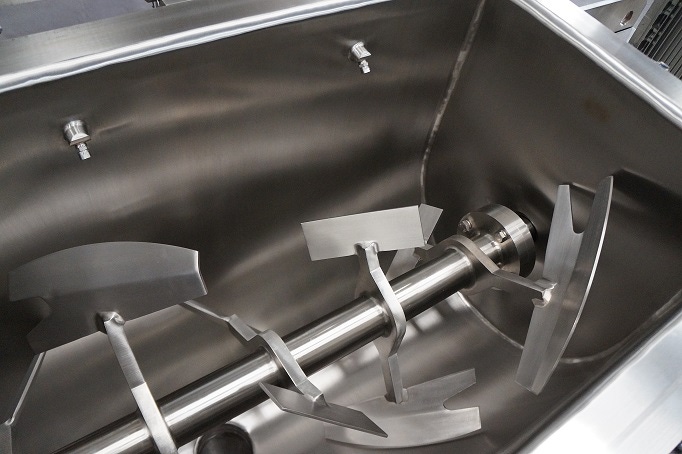Vacuum Blending and Drying Technology: A Second Look
January 23, 2020

Although often presupposed nowadays, one of the most important underlying processing variables in a mixing operation is vacuum. Vacuum technology within the context of mixing, as well as drying, has been a game-changer since it was originally pioneered in the 1970s. Subjecting a product to 29 in. Hg vacuum or deeper often leads to a multiplicity of dramatic effects. For instance, vacuum allows for decisively faster integration of additive phases, such as scents, flavors, colors, and even APIs. It boils off moisture and solvents at much lower temperatures, leaving heat-sensitive components undamaged. A deaerated environment may promote better interaction between discrete particles resulting in efficient homogenization. For other products, deoxidation is necessary in preserving sensitive ingredients and thwarting unwanted chemical reactions or microbial growth. Blending and drying under vacuum pervades a wide range of solids processing. Here we review four fundamental blending and drying systems and the benefits they offer in conjunction with vacuum.
Ribbon Blenders: A Classic Approach
Engaging the principle of large-scale random motion, the ribbon blender particularly demonstrates convective high-speed mixing among solid-solid blending systems. A ribbon blender consists of a U-shaped horizontal trough and an agitator made up of inner and outer helical ribbons that move material in opposite directions. The ribbons rotate up to approximately 300 ft/min and move materials both radially and laterally. The rotating element can also be replaced with a paddle design agitator for gentler handling of friable ingredients. Ribbon blenders have a flexible height, with optional longer legs for multi-level material transfer or a shorter design for low-profile loading systems.
Simple in design and highly scalable to very large batch volumes —over 500 cu ft – the ribbon blender is most often used for straightforward mixing of free-flowing powders, as well as rudimentary incorporation of a liquid phase into a solid blend under atmospheric conditions. When built for vacuum and supplied with a heating jacket around the trough, the ribbon blender is a good option to consider for quickly removing moisture from powders or pellets, especially on a grand scale. Basic limitations of this classic design are that they must typically operate with at least 30-40% of the rated capacity for effective blending depending on the application and they do not easily facilitate complete discharge due to the horizontal orientation.
Click here for information about the upcoming International Powder & Bulk Solids Conference/Exhibition
Vertical Blenders: When You Need to Go High
While used in a limited number of industries for simple solid-solid blending under ambient conditions, vertical or “cone screw” blenders are predominantly used for vacuum drying applications. The blending action of the vertical blender’s slow turning screw is far gentler than that of a ribbon blender. Supported from the top, the blending auger orbits a conical vessel wall while it turns and gently lifts material upward. The materials are conveyed to the uppermost batch level towards the periphery of the vessel, and then move slowly back down the center, while mixing with materials being moved upward by the orbiting screw. Due to its low speed requirements, this machine requires the least power among other blending options.
If floor space is tight, consider going up with a vertical blender since it requires a small footprint. Because of their conical geometry, vertical blenders are capable of 100% discharge and can operate efficiently with batches as small as 10% of the maximum operational volume. The main disadvantage of this design, though, comes to light when trying to process bulk densities above 100 lb/cu ft. Vertical blenders are best suited for batching low-density applications on a smaller scale. Geometrically speaking, this is a planetary design, as the orbital arm and the rotating auger revolve on their own axes. It’s especially important to choose a reliable manufacturer — the orbital arm gear assembly is mechanically complex, making it difficult and expensive to repair. Select a vertical blender with no seals or bearings submerged in the product (i.e. screw design unsupported at the lower end) to simplify maintenance.
Tumble Blenders: Gentle Does it
The tumble blender is uniquely suited for formulations with extremely minor active components or additives. It is also ideal for processing high-value and delicate applications with low-shear requirements. Essentially a rotating device, the tumble blender comes in a variety of geometries, the most common being the V-shaped or double-cone configurations. The vessel is partially loaded with product and rotated at operating speeds in the range of 5 to 25 rpm. The tumble blender mixes under the mechanism of diffusion: batch materials cascade down, distributing particles over a freshly exposed surface as the vessel rotates along a horizontal axis.
Widely popular in the pharmaceutical industry, the tumble blender is often provided in a sanitary all-stainless steel construction. The vessel geometry facilitates 100% product discharge. Options for process optimization include vacuum design, heating jacket, and an intensifier bar for deagglomerating clumps.
The tumble blender can easily handle bulk densities up to around 400 lb/cu ft, but heavy-duty designs will accommodate 700 lb/cu ft. Cost-effective and scalable, this machine is a valuable choice for many applications. It does, however, occupy a larger footprint compared to other blenders of the same capacity. It must be equipped with a safety railing and requires a large secure area dedicated just for the blender. Finally, drying is tricky in a tumble blender. Make sure the manufacturer is experienced with vacuum sealing and constructs the tumble blender with safety in mind.
Cylindrical Blender/Dryers: Turn up the Heat
Cylindrical blender/dryers are designed for extremely efficient and reliable drying through the combination of thorough blending, deep vacuum, and a baffled jacket that surrounds the entire cylinder and end plates enabling tight temperature control. These machines accommodate a wide range of feed forms, from free-flowing powders and pellets to wet granules and paste-like materials. Benefiting from a shape naturally conducive to deep vacuum, these blenders meet very high temperature requirements up to 500°F. Finite Element Analysis (FEA) is often necessary for calculating very accurate tolerances to accommodate shaft expansion during processing at high temperatures. The gearbox and all bearings are located outside of the drying chamber and not subjected to the same temperature as the materials being processed. Inside the cylinder, product is blended by a ribbon, paddle, or combination ribbon/paddle agitator.
Drawbacks include smaller bulk charging ports due to the priority of the total-jacketing, as well as challenges in cleanability and accessibility. Overall, however, this contender is capable of the most demanding heating and drying applications.
Double Planetary Mixers: A Surprising Candidate
While well known for their ability to mix viscous or dilatant materials, double planetary mixers are actually also effective in blending solids that are dry, dense, and not free-flowing. Perhaps not many engineers know that this vertically-oriented change-can mixer is excellent for blending and drying metal powders, and even preparing granulations. Today’s typical double planetary mixer is almost always vacuum-capable. It mixes product by rotating two identical blades on their own axes as they orbit on a common axis. The blades contact virtually every point of the batch after only 36 revolutions and continuously move new materials from the sidewalls to the center of the vessel, ensuring highly efficient heat transfer and fast drying.
Double planetary mixers can be built in very small capacities -- as little as a half-pint. Design limits include lower operating temperatures around 400°F and maximum capacity of 1,000 gal. The cost is also higher compared to conventional blenders and dryers.
Consider single-pot processing in a double planetary mixer to meet multiple objectives: blend powders; melt solids; thoroughly coat solids with a small amount of liquid; mix slurries and pastes; prepare shear-sensitive gels, fiber-filled mixtures or abrasive compounds; knead dough-like materials; remove excess moisture from a granulation; transform wet pastes into free-flowing powders under vacuum – all in one machine. Especially in the R&D stage, the versatile double planetary mixer can outperform more obvious blender/dryer options by a wide margin.
John Ross has been with Charles Ross & Son Co., Hauppauge, NY, for three years. The company manufactures mixing, blending, drying, and dispersion equipment, available in either standard or custom designs, to meet specific processing needs. For more information, call 631-234-0500 or visit www.mixers.com.
Here are more articles that may interest you:
How to Find the Right Mixer for Your Application
Powder Mixing Challenges and How to Overcome Them
Mixer Selection: 3 Tips for Success
Benefits of Tumble Blenders and Dryers
Mixing Strategies for High-Solids Applications
You May Also Like


